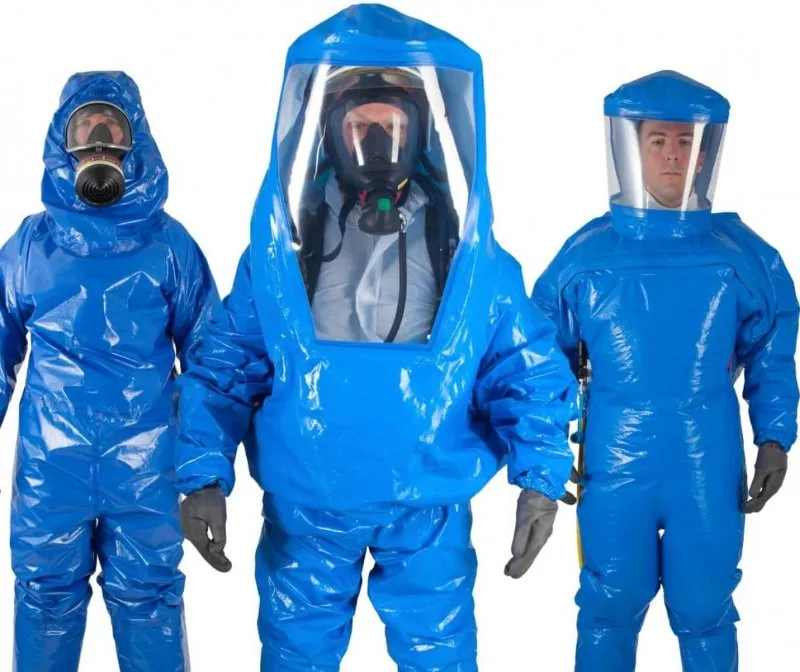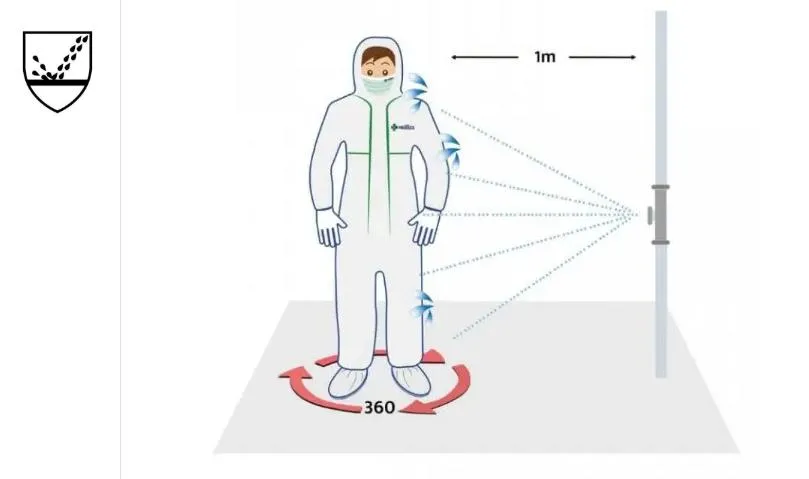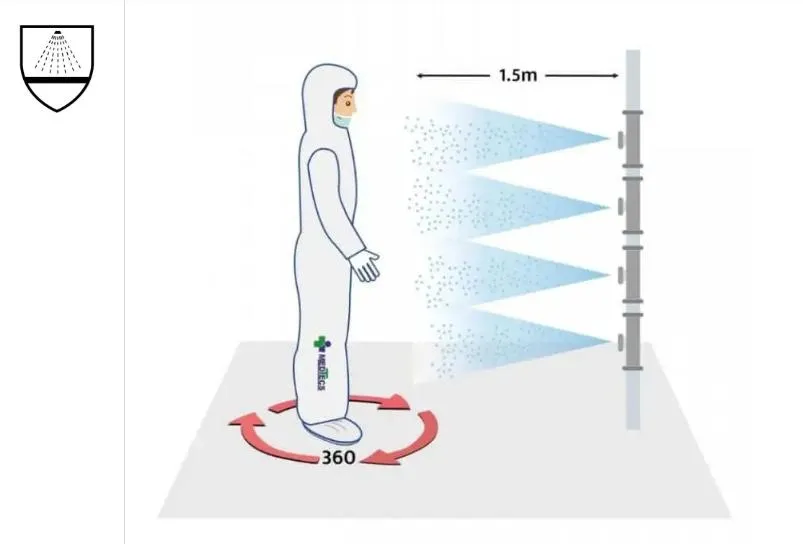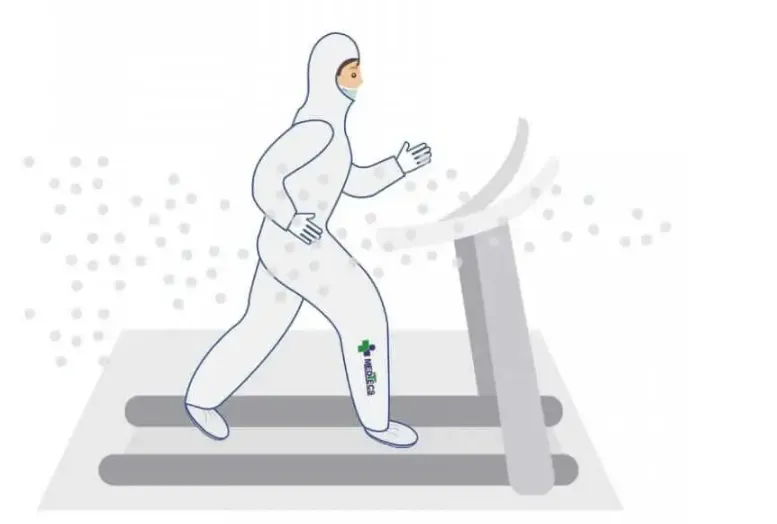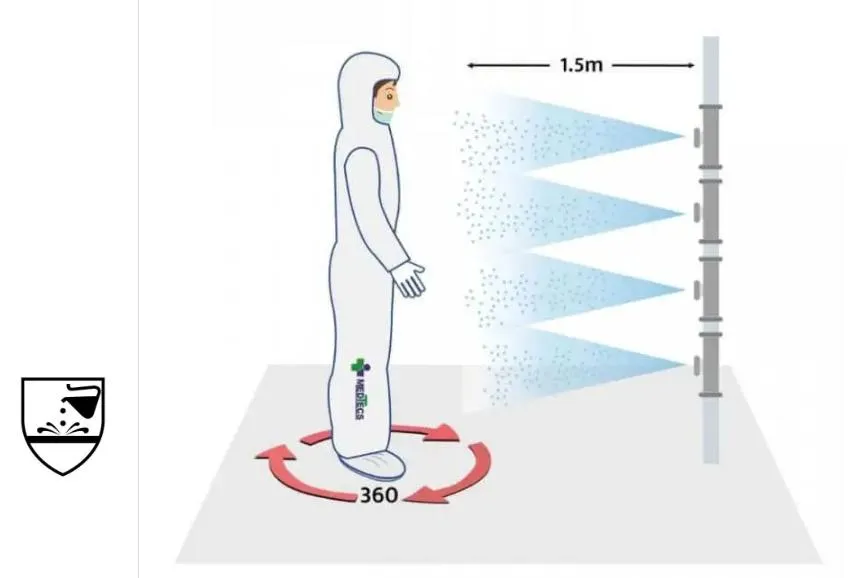Many workers face confusion when choosing protective suits because there are so many types and standards. Picking the wrong one can leave you exposed to chemicals, dust, or liquids. Disposable coveralls from Type 1 to Type 6 each serve a different purpose, from full chemical protection to light dust shielding. Understanding these types helps you select the right suit for your specific job and safety needs.
Type 1 Disposable Coveralls: Gas-Tight Protection for Hazardous Environments
Type 1 disposable coveralls provide the highest level of protection. They are designed to be gas-tight, preventing harmful gases, vapors, aerosols, and liquids from entering.
Classification and Standards of Type 1 Coveralls
Regulated under EN 943-1 standard.
Three subtypes:
- Type 1a: SCBA (self-contained breathing apparatus) worn inside the suit.
- Type 1b: SCBA worn outside the suit.
- Type 1c: Uses a compressed-air hose system.
Type 1 coverall suits meet strict requirements for chemical protection and are similar to US Level A suits.
Typical Uses of Type 1 Coveralls
Chemical manufacturing plants
Emergency response teams handling chemical spills
Hazardous material (HazMat) operations
Protective Features and Materials of Type 1 Coveralls
Constructed with multilayer, chemically resistant fabrics like polypropylene/polyethylene.
Seams are welded or taped to prevent leaks.
Includes tight seals at the hood, wrists, and ankles for full coverage.
Size Range of Type 1 Coveralls
Available in sizes from S to XXXL, accommodating chest measurements from 84 cm to 132 cm and heights from 164 cm to 200 cm.
Summary Table
| Disposable Coverall Feature | Detail |
|---|---|
| Protection Level | Gas-tight (against gases, liquids) |
| Main Standard | EN 943-1 |
| Subtypes | 1a (SCBA inside), 1b (SCBA outside), 1c |
| Material Example | Multilayer PP/PE, Tychem® 4000 |
| Chemical Resistance | 124+ chemicals, 30+ min protection |
| Burst Strength | 71 psi |
| Typical Applications | Chemical plants, emergency responders |
| Available Sizes | S to XXXL |
| Notable Manufacturers | DuPont, Respirex, Sir Safety System |
Type 1 gas-tight disposable coveralls are essential for workers facing dangerous chemical gases and liquids, providing full-body protection in the most hazardous conditions.
Type 2 Disposable Coveralls: Chemical and Particle Protection
Type 2 disposable coveralls provide a non-gas-tight but positive pressure barrier, designed to protect against liquids, vapors, and dust where gas exposure is not the primary concern. Classified under EN 943-1 Type 2, these coveralls offer limited spray-tightness with strong resistance to hazardous materials.
Key Features of Type 2 Coveralls
Protection level:
Effective against many liquid chemicals, hazardous particulates, and limited harmful vapor exposure. Not suitable for continuous or direct gas exposure.
Materials:
Typically made from multilayer polypropylene/polyethylene laminates, around 88gsm, for durability and chemical resistance.
Seams:
Ultrasonically tape-welded or sealed with self-adhesive storm flaps for enhanced leak protection.
Design:
Includes elasticated cuffs, hood, waist, and ankles to ensure a snug fit. Features like self-adhesive chin straps and zipper storm flaps further improve barrier integrity. Thumb loops prevent sleeve movement.
Positive pressure:
This design pushes any leaks outward, reducing inward contamination risk.
Certifications:
Complies with EN 943-1 Type 2 (spray-tight, non-gas-tight), plus often meets EN 1149-5 (anti-static), EN 14126 (biohazard), and EN 1073-2 (radioactive particle) standards.
Common Applications of Type 2 Coveralls
Handling chemicals and cleaning spills in non-gas environments
Emergency response and decontamination tasks
Industrial and pharmaceutical manufacturing
Laboratory or medical settings requiring protection from biological hazards
Example Size Chart for Type 2 Coveralls
| Size | Chest (cm) | Height (cm) |
|---|---|---|
| S | 84–92 | 164–170 |
| M | 92–100 | 170–176 |
| L | 100–108 | 176–182 |
| XL | 108–116 | 182–188 |
| XXL | 116–124 | 188–194 |
| XXXL | 124–132 | 194–200 |
Performance Overview of Type 2 Coveralls
Fabric weight:
Approximately 88 gsm for a balance of protection and comfort.
Seam strength:
Tape-welded seams offer superior leak resistance compared to standard stitching.
Barrier testing:
Designed to withstand high chemical permeation levels, depending on specific chemicals involved.
Practical Use Cases of Type 2 Coveralls
Emergency workers rely on Type 2 suits for splash protection without the need for gas-tight seals.
Pharmaceutical and biotech industries use these coveralls during cleaning and maintenance with aggressive chemicals.
Nuclear facilities apply Type 2 suits for dust and limited liquid protection in maintenance operations.
Summary
Type 2 disposable coveralls are ideal for environments where liquid splashes, chemical vapors, and airborne particulates pose a risk, but full gas-tight protection is unnecessary. Their positive-pressure design and robust materials offer reliable defense and help prevent inward contamination, making them widely used in industrial, medical, and emergency settings.
Type 3 Disposable Coveralls: Liquid-Tight Protection Suits
Type 3 disposable coveralls provide liquid-tight protection by using sealed seams that prevent hazardous liquids from penetrating the suit. These seams are usually ultrasonically welded or over-taped, offering a complete barrier equal to or better than the fabric itself.
Applications and Usage of Type 3 Coveralls
These coveralls are ideal for work involving:
- Chemical splashes
- Infectious liquids
- Pressurized cleaning
Common industries include chemical manufacturing, petrochemical plants, waste treatment, EVD (Ebola Virus Disease) units, industrial cleaning, and environmental remediation.
Performance and Standards of Type 3 Coveralls
Type 3 coveralls meet strict safety requirements:
Comply with EN14605:2005+A1:2009 for liquid-tight protection.
Resist viral penetration according to ISO 16604:2004, class 2, tested at 1.75 kPa pressure.
Provide resistance to infective agents (Class 6) and hydrostatic pressure.
Mechanical durability includes abrasion resistance of over 2,000 cycles and flex cracking resistance of 100,000 cycles.
Strong tensile strength:
MD >71.7 N, CD >50.8 N
.
Materials and Features of Type 3 Coveralls
Typical materials and design details:
Made mainly of polypropylene/polyethylene foil (~88 g/m²), or specialized fabrics like Chemprotex™ 300 or Tyvek® 800.
Available sizes range from M to 3XL.
Designed with an elasticated hood, cuffs, ankles, thumb loops, and a taped or zip-covered storm flap for a tight seal.
Features antistatic treatment on both sides.
Free from natural rubber or latex, reducing allergy risks.
Common colors include white, yellow, and orange.
Price example: Around $8.15 per suit (e.g., UNICEF Type 3b XL).
Example Products of Type 3 Coveralls
PROMAX C4000 Disposable Coverall
: Offers Class 6 abrasion and flex resistance, ultrasonic welded seams, zippered with storm flap, elasticated cuffs, and hood.
DuPont Tyvek® 800
: Serged and over-taped seams, chin flap for a tight seal, suitable for particles as small as 1 micron, oil repellent, and latex-free since 2023.
SplashMaster by Respirex
: Lightweight hooded coverall suit made with Chemprotex™ 300 fabric, designed to be worn with full face masks.
Packaging and Labelling of Type 3 Coveralls
Each coverall is individually sealed in a clear plastic bag.
Labels provide manufacturer information, size, protection type, and compliance details, often using standardized symbols.
Important Usage Notes of Type 3 Coveralls
Properly taping cuffs, ankles, hood, and zipper flap is critical to maintain liquid-tightness.
These coveralls are single-use and non-sterile; dispose of them safely in biohazard containers after use or contamination.
Certification and Regulation of Type 3 Coveralls
Compliant with EU Regulation 2016/425, classified as Category III Personal Protective Equipment.
Must pass the jet test (EN ISO 17491-3) for chemical spray resistance.
Some models hold EN 1073-2 certification for protection against radioactive contamination.
Type 4 Disposable Coveralls: Spray-Tight Chemical Protection
Type 4 disposable coveralls are designed to protect against hazardous liquid chemical sprays. They are essential in industries like agriculture, industrial cleaning, paint spraying, and hazardous waste cleanup.
Key Standards and Certifications of Type 4 Coveralls
Meet EN ISO 14605 Type 4-B for protective clothing against liquid chemical spray.
Often carry CE certification and EN 14126 for resistance to infective agents.
Material and Construction of Type 4 Coveralls
Made from microporous film laminates or polypropylene/polyethylene multilayers with about 88 GSM weight.
Reinforced front and sleeves increase durability and impermeability.
Use SMS (Spunbond-Meltblown-Spunbond) back panels to improve breathability and reduce heat stress.
Barrier Performance of Type 4 Coveralls
Effectively resists penetration by chemicals like 10% sodium hydroxide, 30% sulfuric acid, and isopropanol.
Provides a particle barrier down to 0.5 microns.
Seams are taped to maximize liquid spray resistance during movement.
Comfort and Fit of Type 4 Coveralls
Features elasticized hood, wrists, ankles, and waist to reduce gaps.
Includes two-way front zippers with storm flaps for easy wearing and removal without compromising protection.
Designed to be low-linting, suitable for cleanroom use.
Common Uses of Type 4 Coveralls
Agriculture:
Protection during pesticide and herbicide spraying.
Industrial Cleaning:
For chemical spray washing in food, beverage, or pharmaceutical plants.
Paint and Industrial Spraying:
Blocks paint, mists, and solvents.
Hazardous Waste Cleanup:
Guards against chemical spills and contaminants.
Example Product of Type 4 Coveralls
The 3M™ Protective Coverall 4565 offers Type 4/5/6 protection with red taped seams for easy ID. It is certified to EN Type 4/5/6 and EN 14126, available in sizes S to 4XL.
Summary: Type 4 Coveralls At a Glance
- Spray-tight liquid chemical barrier
- Reinforced seams and critical zones
- Breathable SMS rear panels
- Single-use to avoid contamination
- Weight between 60-90 GSM for a balance of protection and mobility
Type 4 disposable coveralls deliver strong, spray-tight protection and comfort for workers in critical, hazardous environments.
Type 5 Disposable Coveralls: Protection Against Hazardous Solid Particulates
Type 5 disposable coveralls are specially designed to shield workers from harmful solid particles like dust, fibers, and powders. These include dangerous materials such as asbestos and airborne particles found in various industrial environments.
Key Features and Standards of Type 5 Coveralls
Standard Compliance:
Meets EN 13982 requirements for protection against hazardous dry particles.
Materials:
Commonly made from SMS (Spunbond-Meltblown-Spunbond) fabric or microporous laminated fabric. These materials offer strong barrier protection while remaining breathable.
Protection:
Blocks dust particles as small as 0.01 microns, preventing penetration and reducing exposure risks.
Typical Uses and Industries of Type 5 Coveralls
Asbestos Removal:
Essential for protecting workers from microscopic fibers that cause severe diseases like asbestosis and mesothelioma.
Demolition and Renovation:
Prevents inhalation and skin contact with dust from insulation, drywall, and other hazardous building debris.
Pharmaceuticals, Manufacturing, Construction:
Used where handling or generating powders and particulates is common.
Other Fields:
Spray painting, agriculture, printing, and hazardous chemical handling.
Performance and Design Details of Type 5 Coveralls
Antistatic Properties:
Helps reduce static risks in environments with flammable dust or vapors.
Non-linting Fabric:
Limits fiber release, ideal for cleanrooms and pharmaceutical use.
Elasticated Openings:
Hood, wrists, and ankles have elastic closures to minimize dust entry.
Comfort and Durability:
Materials balance protection with breathability for long-term wear.
Compatibility:
Designed to work with most types of respiratory protective equipment.
Certifications and Choosing the Right Disposable Coverall
Always ensure the coveralls comply with EN 13982 and other relevant standards.
Look for key features such as double storm flaps over zippers, antistatic treatments, and proper fit to maximize protection.
Market Examples and Options
Brands like Chemsplash® Eka 55 and Chemsplash® Xtreme 50 SMS offer reliable Type 5 coveralls.
Tyvek Type 5/6 coveralls and suits from Max Gear UK are popular choices.
Some Type 5/6 coveralls come sterile or irradiated for cleanroom environments, important for the biopharma and microelectronics sectors.
Type 6 Disposable Coveralls: Light Liquid Splash Protection
Type 6 disposable coveralls are designed to protect against light liquid splashes and sprays. They are ideal for environments with minimal chemical exposure and low-risk tasks.
Key Features and Materials of Type 6 Coveralls
Elasticated hood, cuffs, and ankles for a snug fit to prevent liquid entry.
Bound seams increase resistance to liquid penetration.
Zipper closures come with a re-sealable flap to reduce leaks.
Type 6 disposable coveralls are made from lightweight, non-woven materials like microporous film laminate, SMS polypropylene, or flashspun polyethylene (Tyvek®).
Often treated to be antistatic on both sides.
Materials must pass viral penetration tests at a minimum pressure of 1.75 kPa (Class 2).
Usually white in color and free of rubber or latex components.
Certifications and Standards of Type 6 Coveralls
Complies with EN 13034:2005+A1, Category III, Type 6 for chemical protective clothing.
Often meets EN 14126 for protection against infectious agents, useful in medical and laboratory settings.
Can be certified under EN 1073-2 (Class 1) for protection from radioactive particles.
Cost and Performance of Type 6 Coveralls
Among the most affordable chemical protective coveralls.
Example price: about $5.29 USD per unit (size M) based on UNICEF Supply Catalogue.
Provides liquid resistance but is not fully impermeable.
Not suitable for high-pressure chemical sprays or prolonged immersion.
Typical Uses of Type 6 Coveralls
Infection control in isolation units.
Tasks with potential for light chemical splashes, like cleaning and maintenance.
Low-level exposure in pharmaceutical, lab, and construction settings.
Fabric Comparison
| Fabric Type | Breathability | Liquid Protection | Example Brand |
|---|---|---|---|
| Flashspun Polyethylene | High | Low to Moderate | Tyvek® |
| Microporous Film Laminate | Moderate | High | MicroMax NS |
| SMS Polypropylene | High | Moderate | Chemsplash Xtreme |
Microporous film laminate offers the highest liquid protection for Type 6 coveralls.
SMS and Tyvek® provide better breathability but lower splash resistance.
Summary
Type 6 disposable coveralls are best for temporary, single-use scenarios where affordability and basic splash protection are key. They are not meant for high-risk chemical environments but are effective against brief, light liquid exposure.
Quick Comparison: Disposable Coveralls by Work Environment
| Coverall Type | Protection Focus | Typical Industry/Use | Material Examples | Key Feature / Standard |
|---|---|---|---|---|
| Type 1 |
Gas-tight protection (gases, vapors, liquids) | Chemical plants, HazMat response, emergency teams | Multilayer PP/PE, Tychem® 4000 | EN 943-1, SCBA integration, full-body sealed |
| Type 2 |
Limited gas and liquid barrier (positive pressure) | Chemical handling, lab, pharma, decontamination | Multilayer PP/PE laminates (~88gsm) | EN 943-1 Type 2, spray-tight, positive pressure |
| Type 3 |
Liquid-tight protection (splashes & pressurized liquids) | Chemical handling, EVD units, industrial cleaning | PP/PE foil, Chemprotex™ 300, Tyvek® 800 | EN 14605, sealed seams, Class 6 viral resistance |
| Type 4 |
Spray-tight chemical protection | Agriculture, paint spraying, and industrial cleaning | Microporous film laminates, PP/PE multilayers (~88gsm) | EN ISO 14605 Type 4-B, reinforced seams, breathable SMS panels |
| Type 5 |
Protection against solid particulates/dust | Asbestos removal, demolition, and pharmaceuticals | SMS, microporous laminated fabrics | EN 13982-1, dust-tight, antistatic, non-linting |
| Type 6 |
Light liquid splash protection | Maintenance, low-risk lab or pharmaceutical tasks | Microporous film, SMS, Tyvek® | EN 13034 Type 6, single-use, splash-resistant, breathable |
Key Features to Consider When Choosing Disposable Coveralls
When selecting disposable protective coveralls, it’s important to focus on several key features to ensure safety, comfort, and proper protection in your work environment.
Durability and Fit of Disposable Coveralls
Reinforced stitching and tight-fitting elements like hoods, cuffs, and boot covers improve durability.
A secure fit minimizes contaminant entry and enhances protection.
Correct sizing is essential for coverage and ease of movement, following standards like ANSI/ISEA 101-2014.
Breathability of Disposable Coveralls
Breathable materials such as microporous films and SMS fabrics provide airflow.
These materials are ideal for hot conditions or when wearing coveralls for long hours.
Maintaining breathability helps reduce discomfort and overheating.
Protection Levels and Certifications of Disposable Coveralls
Disposable coveralls come with different protection levels designed for specific hazards:
- Type 1: High chemical protection for hazardous exposure.
- Type 5: Protection against airborne solid particles (dust, asbestos), certified by EN13982-1.
- Type 6: Limited protection against light liquid splashes, certified by EN13034.
Important certifications and standards to look for include:
ANSI/ISEA 101-2014 (U.S.) – sizing, packaging, labeling.
EN standards like EN13034, EN13982-1, and EN14126 (biological hazards).
OSHA regulations and NFPA standards for flame resistance when needed.
Matching Coveralls to Workplace Hazards
Choose disposable coveralls based on the specific risks in your workplace:
For chemical exposure: Type 6 coveralls with microporous materials.
For dust and particle work (e.g., construction, milling): Type 5 coveralls using materials like polypropylene or Tyvek™.
For biological hazards (medical or labs): EN14126-certified garments.
For fire risks: Flame-resistant fabrics such as Nomex.
Disposable Coverall Materials Commonly Used
Tyvek™: Cleanroom and particle protection.
Microporous film: Breathable and liquid-resistant.
SMS (Spunbond/Meltblown/Spunbond): Good balance of filtration and breathability.
Polypropylene: Basic dust and debris protection.
Practical Advantages
Disposable coveralls are lightweight, allowing easy movement.
Single-use nature ensures 100% cleanliness, minimizing contamination risk.
Low purchase and disposal costs without maintenance.
Proper storage and periodic inspection help maintain protective qualities.
Disposable Coveralls vs Reusable Coveralls: Cost and Environmental Impact
When choosing disposable coveralls, it’s important to consider not only the upfront cost but also ongoing expenses. Disposable coveralls usually cost less per unit initially. However, because they are for single use, you have to keep buying them, and disposal adds extra expenses. On the other hand, reusable coveralls cost more at first but can be washed and used many times, lowering the overall cost per use.
Environmental Impact of Disposable Coveralls
Disposable coverall suits have a larger environmental footprint. Studies based on life cycle assessment (LCA) data show that:
Global warming potential (GWP): Disposable coveralls cause more CO₂ emissions during raw material extraction, manufacturing, and transport.
Pollution: They contribute more to acidification, water pollution, ecotoxicity, and even human health risks due to chemicals released in production.
Waste: Using disposable coveralls creates up to 20 times more landfill waste per 1000 uses compared to reusable ones.
Energy and emissions: Reusable coveralls cut greenhouse gas emissions by 57% and use 56% less energy across their lifetime.
Advantages of Reusable Coveralls
Reusable coveralls generally have a better environmental profile. They produce much less waste and reduce emissions. For example:
- They cut landfill waste by 94–96%.
- One reusable coverall can often be used 15 to 20 times before replacement.
- For every 1000 uses, reusable coveralls generate significantly less solid waste and fewer greenhouse gases than disposable ones.
The main downside of reusable coveralls is that they need more water for washing and textile processing. However, this can be partly offset by using eco-friendly materials like organic cotton or recycled polyester.
Eco-Friendly Options and Sustainability
To improve sustainability, consider:
Using organic cotton and recycled polyester made from PET bottles in reusable coveralls.
Manufacturing is powered by renewable energy sources such as solar power.
Recycling programs to handle waste from single-use coveralls are emerging, but they currently capture only a small fraction.
Conclusion
Selecting protective coveralls is not only about meeting safety rules but also about building trust with your workers and clients. The right choice shows professionalism, responsibility, and care for people’s health. Many buyers also prefer tailored solutions that match their exact workplace needs, whether in sizing, packaging, or special materials. If your company requires customized disposable coveralls that combine safety with cost-effectiveness, you are welcome to reach out to us for a detailed quotation.

